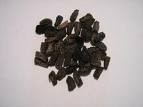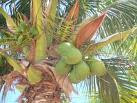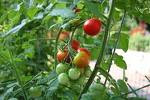 POTATOES,ALOO, SOLANUM TUBEROSUM
POTATOES,ALOO, SOLANUM TUBEROSUMThe common potato has an extremely long history and something of a checkered past. The name potato comes from the Peruvian Quechua language’s
batata which is one of the Latin names of the
yam and the
sweet potato. The potato is a member of the
Solanaceae family along with
nightshade,
tomatoes,
aubergines and
chilli peppers.
Solanum means ‘soothing’ in Latin, so the potato’s name actually means ‘soothing root,’ thus aptly describing the favourite comfort food of many. Potatoes originated in the Andes Mountains in South America around 8,000 years ago, and were cultivated by the indigenous peoples there around 6,000 years ago. The Spanish explorers found them in the 16
th century and took them to Spain. Because of their
vitamin C content they were taken on long voyages to prevent scurvy.
They come in a range of shapes, sizes and colours of flesh and skin, ranging from the usual white or yellow fleshed ones through to blue and purple-fleshed varieties such as the Purple Peruvian and Purple Majestic, Congo is a blue-skinned blue-fleshed variety. In Pakistan they grow Rodeo, Spunta and Diamond varieties for export, but these are the usual colour.

Potatoes have been spurned in the past, as when they were first introduced into Europe, people-especially the French believed that they were the cause of all fatal diseases, from leprosy and syphilis through to any disease which caused an early demise. This edict was passed in Besançon, France, “In view of the fact that the potato is a poisonous substance whose use can cause leprosy, it is hereby forbidden, under pain of fine, to cultivate it.” Later Antoine-Auguste Parmentier, who had been imprisoned in Germany and fed only on potatoes, popularized the poor tuber by a few ruses. He persuaded Louis XIV to grow potatoes and put guards around the patch. The peasants naturally enough then believed that they were valuable and stole them. He also made mashed potatoes from these edible tubers and so they became popular as they tasted divine and didn’t look anything like the root that “caused leprosy.” Marie-Antoinette and the ladies of her court wore potato flowers in their hair rather like the women in James I’s (James VI of Scotland) court, who wore
carrot leaves in their hair.

Sir Walter Raleigh the English explorer or buccaneer, depending upon which way you look at his role in history, brought the potato back to Britain with him from the New World in 1589, and took them to his estate in Ireland near Cork where he planted them. One story is that he presented a potato plant to Queen Elizabeth I who was highly pleased with the gift (along with tobacco) which her favourite had brought. She held a royal banquet in which every course featured potatoes, but the chefs had not been told that it was the tuber they should prepare, so they threw these away and served the stems and leaves of the plant which are poisonous. The wealthy aristocrats all became deathly ill and potatoes were subsequently banned from the royal court.
John Gerard ( 1545-1612), the English herbalist had a more open-mind attitude and grew potatoes in his garden which he called the “potato from the Virginia” although in fact they came from South America, not Virginia in the US. They were grown in London by 1597 and soon became popular in Scotland and Ireland.
Attitudes gradually changed towards the edible root, but in Russia as late as 1774, the peasants refused to eat the free potatoes sent them by Frederick the Great to relieve the famine, and only ate them when he sent troops to “persuade” them to do so.

The German philosopher, Friedrich Nietzsche (1844-1900) had this to say of the potato “A diet that consists predominantly of rice leads to the use of opium, just as a diet that consists predominantly of potatoes leads to the use of liquor.” Of course this is a sweeping generalization but vodka comes from potatoes and the Irish moonshine Potcheen does too.
The Irish cultivated the potato extensively and after the Industrial Revolution it was a popular staple of the working classes who needed a cheap, energy-giving food, so potatoes were the answer. In 1845-49 the Irish suffered from the potato famine and by 1849 the population had been halved, with more than a million people dying at the height of the famine and the rest emigrating to North America and Australia. It was the Scots and the Irish immigrants who began growing potatoes in New Hampshire, USA thus popularizing the vegetable there. Benjamin Franklin had been present at one of Parmentier’s potato feasts so knew the value of this root, and in his presidency (1801-9) Thomas Jefferson served “French Fries” at the White House.
Crisps were said to have been invented by a disgruntled chef, George Crum. Legend has it that the railway magnate, Commodore Cornelius Vanderbilt was dining at an up-market restaurant in Saratoga Springs, USA and sent back his potatoes back because they were too thick. Mr. Crum gave vent to the sarcastic side of his nature and cut the offending potatoes extremely thinly, fried them in oil and threw salt over them and sent them back. Commodore Vanderbilt loved them and so the Saratoga Crunch Chips were the precursors to the crisps we have all over the world today.
Potatoes have won several distinctions; in 1995 they were the first vegetable to be grown in space; 2008 was the UN International year of the Potato. Mr. Potato Head was introduced to the children of the world in 1952.

In the UK alone 94 kilograms of potatoes are consumed every year by each person, and more than 80 varieties of potatoes are grown on a commercial basis and there are more than a thousand varieties grown throughout the world.
Potatoes, especially baked in their skins are very good for our health. They have received a bad press because of the ways they are cooked- particularly when deep-fried in oil that isn’t changed as often as it should be, or cooked in beef dripping (Harry Ramsden’s chips). They are delicious mashed especially with
parsnips and/or
swede or carrots.
Apart from vitamin C they contain the
B-complex vitamins, Vitamins E and K, folate, pantothenic acid,
amino acids and the
minerals, calcium, iron, copper, magnesium, phosphorous, potassium, selenium, sodium and zinc as well as a little Omega-3 and -6. So far researchers have identified 60 different kinds of phytochemicals and vitamins in their skin and flesh, and the phenolic compounds in some varieties rival that of
broccoli,
spinach and
brussel sprouts. They have
bioflavonoids which have protective activity against cardio-vascular disease, respiratory problems and some cancers. A compound found in some varieties (not all have been investigated), kukoamines, has so far only been found in the
wolfberry/Goji berry
Lycium chinensis, and it is believed that this might lower blood pressure. To get the full health benefits from potatoes you should eat them with their skin, and baking them is the best way of doing this. You can top them with almost anything or scoop out the flesh and mash it with boiled eggs, and grated cheese; sprinkle grated cheese on top of the refilled shells and put them back in the oven until the cheese melts. This is a real “comfort food” especially when served with hot baked beans. It’s simple too and packed full of goodness.

There is a lot of folk lore about the potato; one story is that pregnant women wouldn’t eat them in case their babies were born with big heads. If you cut a potato and rub it on a wart then bury the potato, as the potato decays, so the wart will disappear. If someone put a potato peeling on a young girl’s doorstep on May Day it meant they disliked her.
In Britain during the Second World War, people had to survive on what could be grown in Britain (which meant there were no
bananas or citrus fruits), and below is one of the recipes that kept people going. Lord Woolton was Minister for Food during the war years and this recipe is named after him.
WOOLTON’S WARTIME PIE
Ingredients
For the topping
2 lbs potatoes, peeled, chopped, boiled, drained and mashed with butter and milk
Filling
1 lb potatoes, with skins, diced
1 lb swede, peeled and diced
1 lb carrots, scarped and diced
4 spring onions, finely sliced
1 tsp Marmite/Vegemite/other yeast extract or beef or game stock
Method
Preheat the oven to 200˚C/400˚F/gas Mark 6.
Put all the vegetables into a pan and cover with water, so that they are covered to half an inch higher than the layer of vegetables. Stir in the yeast extract and oatmeal. Or use stock in which case you just need to add the oatmeal.
Simmer gently for 15-20 minutes stirring frequently.
Transfer the contents of the pan to a pie dish and top with the mashed potatoes.
Bake in the pre-heated oven for 25 minutes, or until the potatoes have browned.
You could also top this with grated cheddar cheese.
This has Taste and is a Treat.
 Harpago means grappling hook or iron, in Greek, and phytum is plant, procumbens, meaning prostrate describes the way it spreads across the ground as it is a vine-like plant with red, purple or pink trumpet-shaped flowers. These give way to spiny fruits which then produce dark-brown or black seeds. However it is the thick, fleshy secondary roots which have been subject to investigation which is still ongoing. It is related to the little sesame seed.
Harpago means grappling hook or iron, in Greek, and phytum is plant, procumbens, meaning prostrate describes the way it spreads across the ground as it is a vine-like plant with red, purple or pink trumpet-shaped flowers. These give way to spiny fruits which then produce dark-brown or black seeds. However it is the thick, fleshy secondary roots which have been subject to investigation which is still ongoing. It is related to the little sesame seed. The German Commission E has approved its use for dyspepsia, stimulating appetite and resting degenerative disorders of the muscoskeleton. It is an active ingredient of ¾ of prescriptions for arthritis and rheumatism and has been over-harvested to the point where it is under threat of extinction. In Namibia there is a sustainable project which was established to harvest the root set up in 1999 and seeds have been deposited in the Kew Gardens Millennium Seed Bank, so that it won’t actually become extinct because of irresponsible harvesting. Unfortunately it, like the Himalayan Yew has been discovered by the West and so the market for Devil’s Claw roots has exploded.
The German Commission E has approved its use for dyspepsia, stimulating appetite and resting degenerative disorders of the muscoskeleton. It is an active ingredient of ¾ of prescriptions for arthritis and rheumatism and has been over-harvested to the point where it is under threat of extinction. In Namibia there is a sustainable project which was established to harvest the root set up in 1999 and seeds have been deposited in the Kew Gardens Millennium Seed Bank, so that it won’t actually become extinct because of irresponsible harvesting. Unfortunately it, like the Himalayan Yew has been discovered by the West and so the market for Devil’s Claw roots has exploded.














































